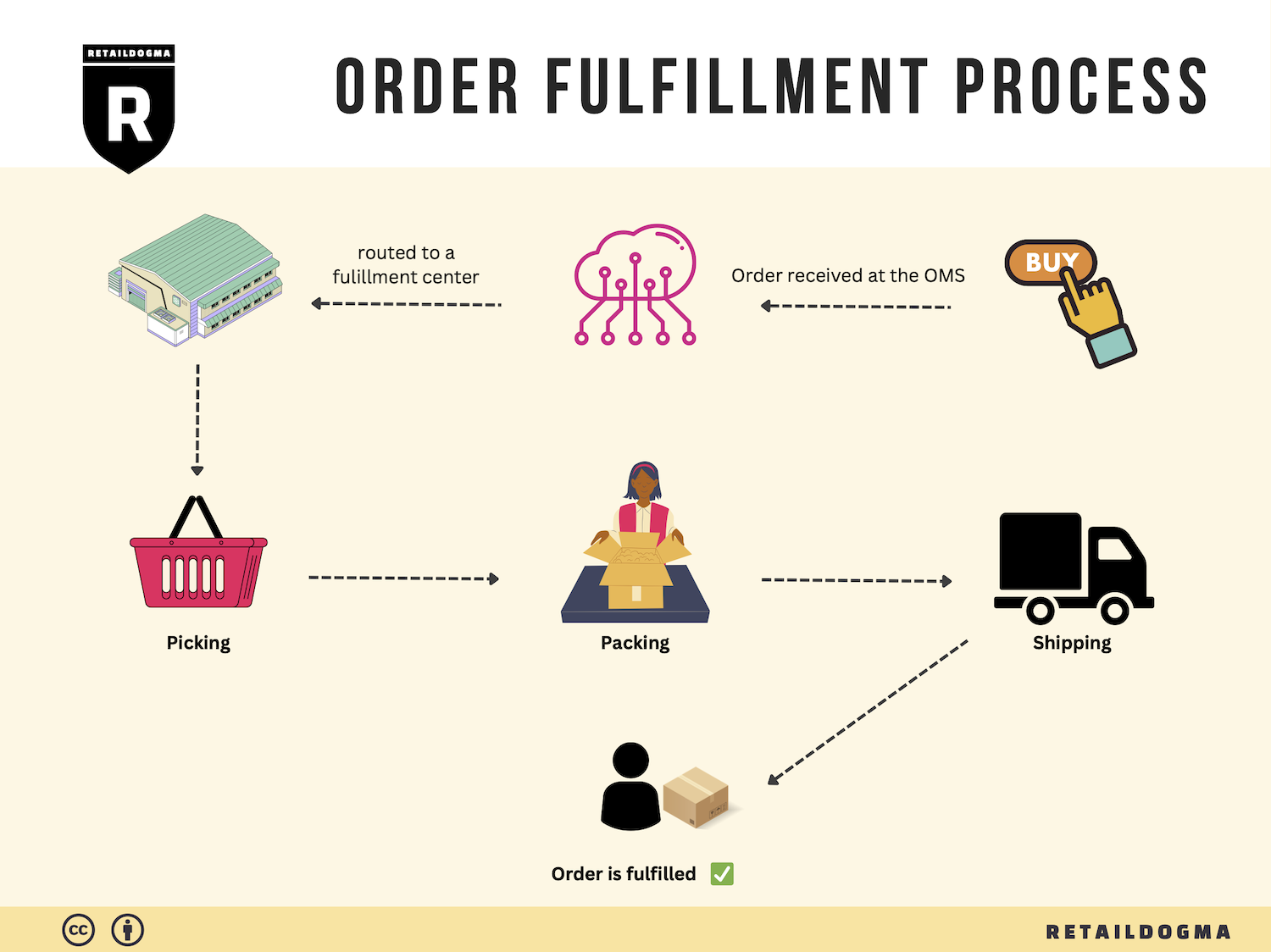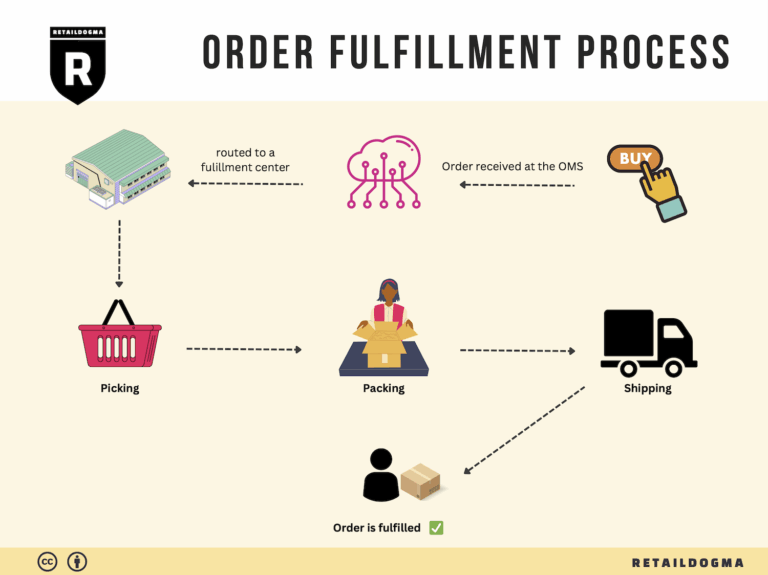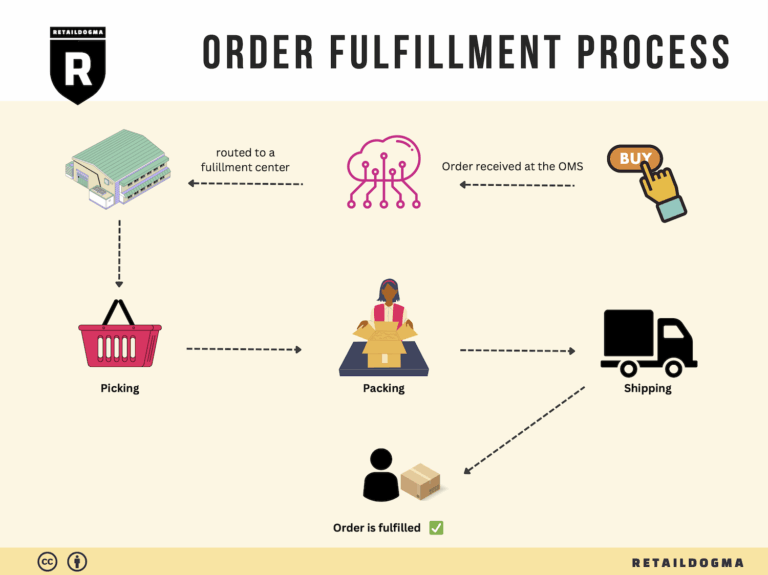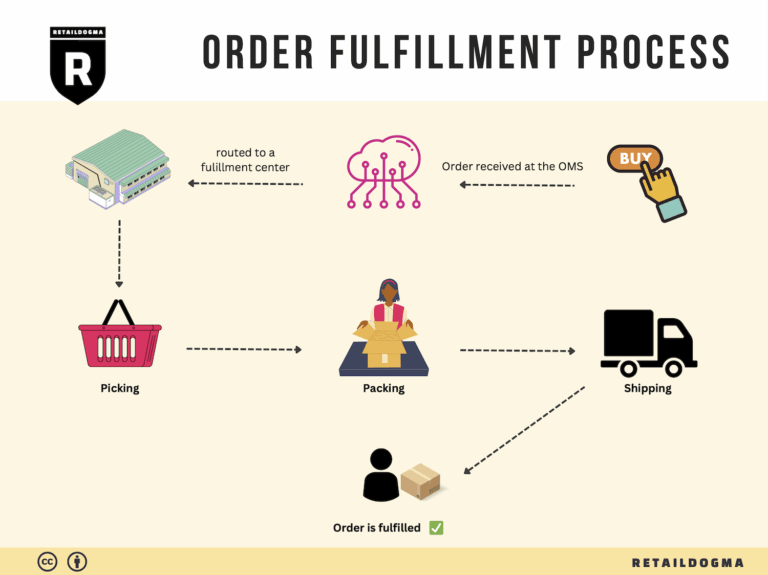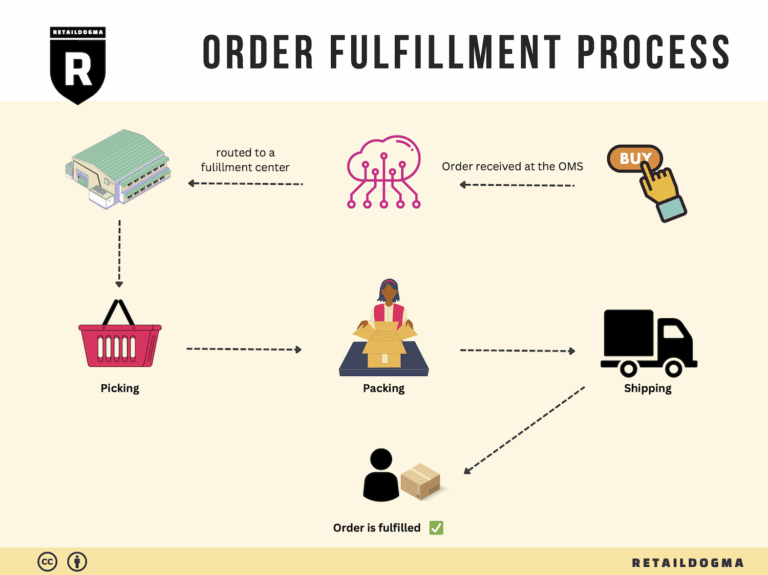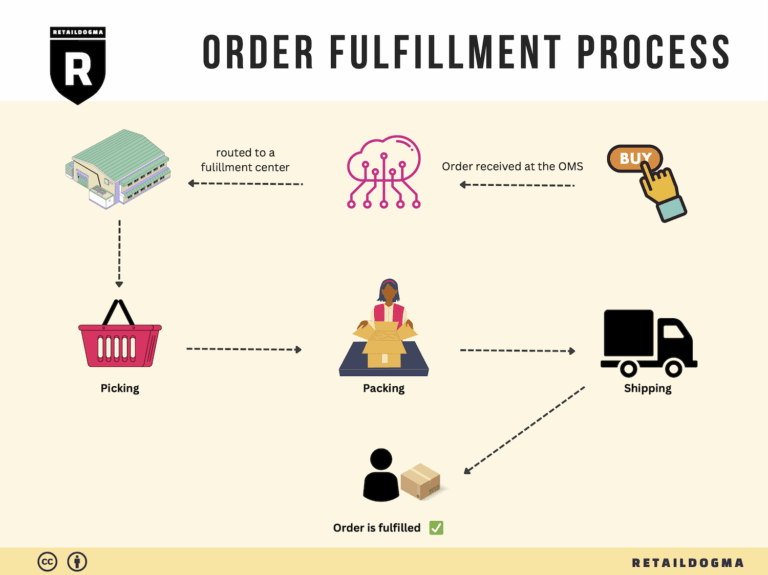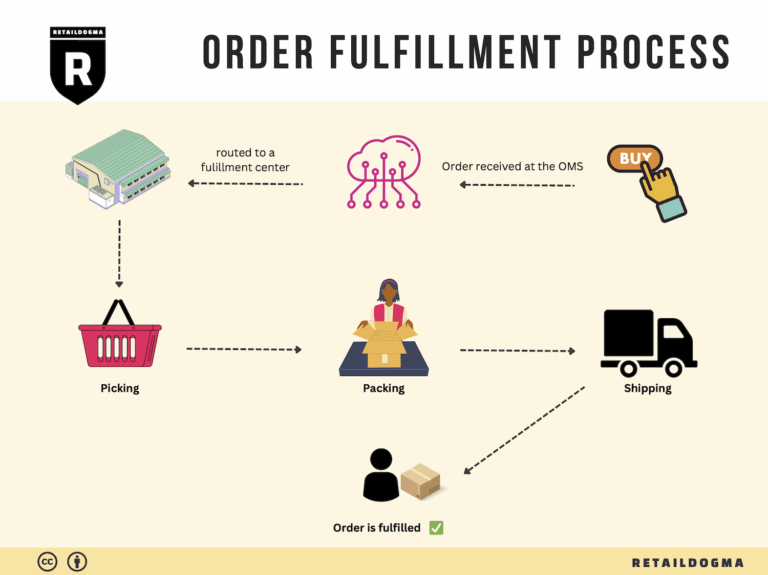What Is A Fulfillment Center? A Complete Guide (2025)
What is E-commerce Fulfillment? An Introduction for Growing Businesses
As e-commerce continues to grow, many online businesses find themselves grappling with the complexities of packing and shipping orders. The excitement of making sales can quickly turn into a daunting task, as entrepreneurs face the logistical challenges of fulfilling customer orders efficiently and accurately. This overwhelming process can divert attention from core business activities, leading to stress and potential losses in customer satisfaction.
E-commerce fulfillment is the backbone of any successful online retail operation. Simply put, it encompasses the entire process of getting a product from your inventory to the customer’s doorstep. This includes receiving and storing products, processing orders, picking and packing items, and managing shipping logistics. Understanding this process is crucial for businesses looking to scale and maintain a competitive edge.
In this guide, we will explore the various models of fulfillment available to online businesses, such as Third-Party Logistics (3PL) and Fulfillment by Amazon (FBA). Each model comes with its own set of advantages and challenges, and selecting the right one can significantly impact your operational efficiency and customer satisfaction.
We will also delve into the core services that fulfillment partners typically offer. These can range from inventory management and order processing to customer service and returns handling. Knowing what services are essential for your business will help you make informed decisions when choosing a fulfillment partner.
Choosing the right fulfillment partner is a critical step in scaling your operations. We will provide practical insights on what to look for in a fulfillment partner, including technology integration, reliability, and service quality. This section will help you assess potential partners based on your unique business needs and customer expectations.
Lastly, we will discuss pricing models in fulfillment services, as understanding the costs associated with different fulfillment options is vital for budgeting and financial planning. We aim to clarify common pricing structures and help you evaluate the cost-effectiveness of various fulfillment solutions.
The goal of this guide is to empower e-commerce businesses with the knowledge to make smart, strategic decisions regarding their logistics. By mastering the fundamentals of e-commerce fulfillment, you can streamline your operations, enhance customer satisfaction, and ultimately drive growth.
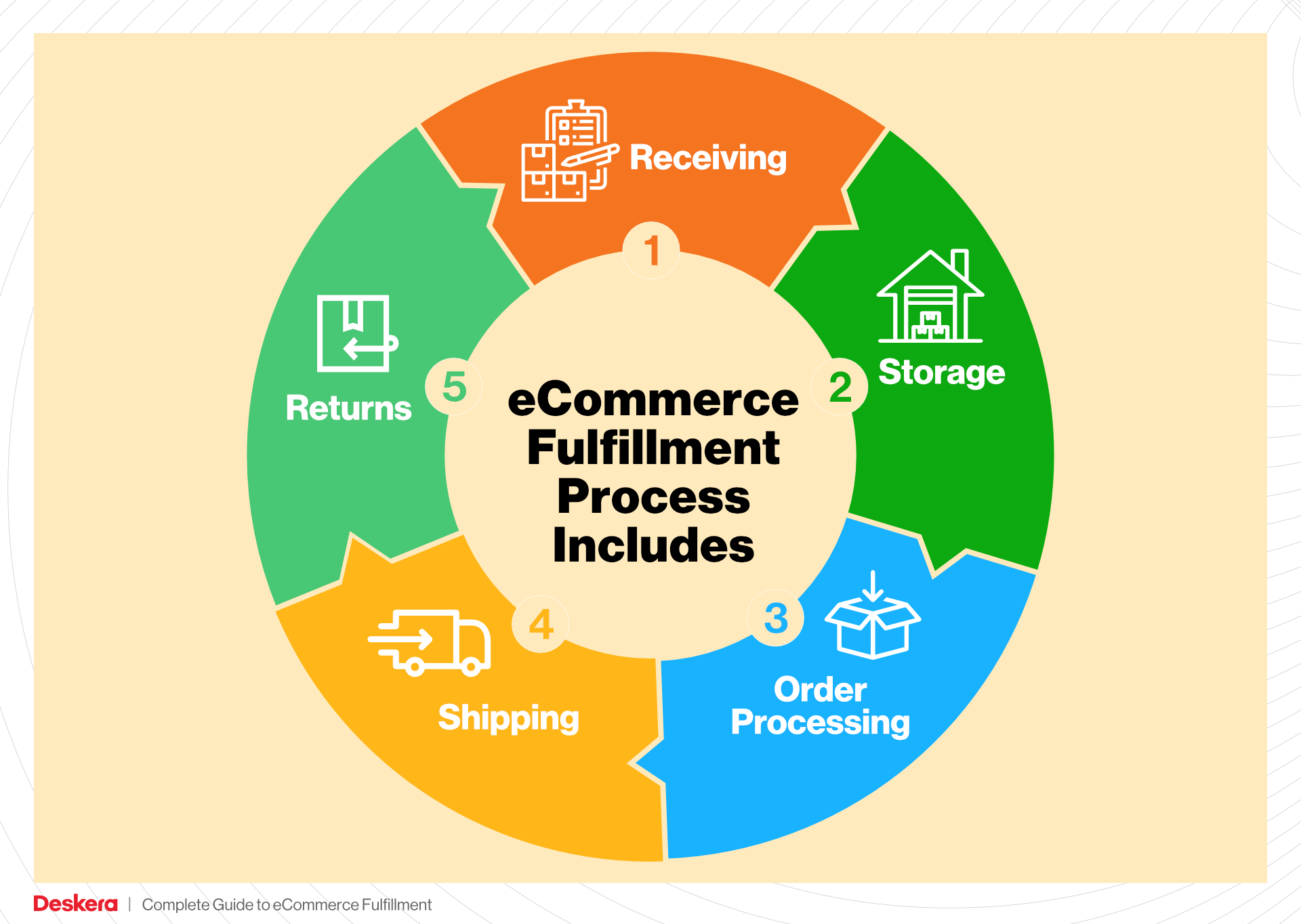
What You’ll Learn In This Guide
- What is E-commerce Fulfillment? An Introduction for Growing Businesses
- The Order Fulfillment Process: From ‘Buy’ Button to Customer’s Door
- Comparing Fulfillment Models: In-House vs. 3PL vs. Dropshipping
- A Deep Dive into Amazon FBA: Pros, Cons, and Who It’s For
- Core Services Offered by Fulfillment Centers
- How to Choose a Fulfillment Partner: A 6-Point Checklist
- Understanding Fulfillment Pricing: A Breakdown of Common Fees
- Frequently Asked Questions (FAQs) about Fulfillment
- Conclusion: Is Outsourcing Fulfillment the Right Move for Your Business?
- Important Disclaimer
The Order Fulfillment Process: From ‘Buy’ Button to Customer’s Door
1. Receiving Inventory
The first step in the order fulfillment process is receiving inventory. This involves the acceptance and inspection of products delivered to the fulfillment center. Upon arrival, products are verified against purchase orders to ensure that the correct quantities and items have been received. This step is crucial because it sets the foundation for the entire fulfillment operation. If discrepancies occur at this stage, they can lead to stockouts or overstock situations, impacting customer satisfaction and operational efficiency.
Key Term: SKU (Stock Keeping Unit)
Each product is assigned a unique SKU, which facilitates tracking and inventory management throughout the fulfillment process. Efficient receiving processes often involve barcode scanning, which allows for quick updates to inventory management systems.
2. Warehouse Storage
Once inventory is received and checked, it is then organized and stored in the warehouse. This stage involves determining the optimal storage locations based on various factors such as product size, demand frequency, and storage capacity. Proper organization is essential for maximizing warehouse space and ensuring that items can be easily accessed when needed.
The layout of the warehouse plays a significant role in the efficiency of the order fulfillment process. For example, high-demand items should be stored closer to the picking area to reduce retrieval time. Additionally, implementing a systematic storage method, like using zones or shelving systems, can enhance operational efficiency.
Key Term: FIFO (First In, First Out)
FIFO is a common inventory management technique that ensures older inventory is sold before newer stock, minimizing the risk of obsolescence and ensuring product freshness, especially for perishable goods.
3. Order Picking
Order picking is the process of retrieving items from their storage locations to fulfill customer orders. This step is critical as it directly affects order accuracy and fulfillment speed. Efficient picking methods, such as batch picking or zone picking, can significantly reduce the time it takes to collect items, thereby enhancing overall productivity.
During this phase, workers use pick lists, which are documents or digital displays that outline the items and quantities required for each order. These lists help ensure that the correct items are selected and assist in maintaining inventory accuracy.
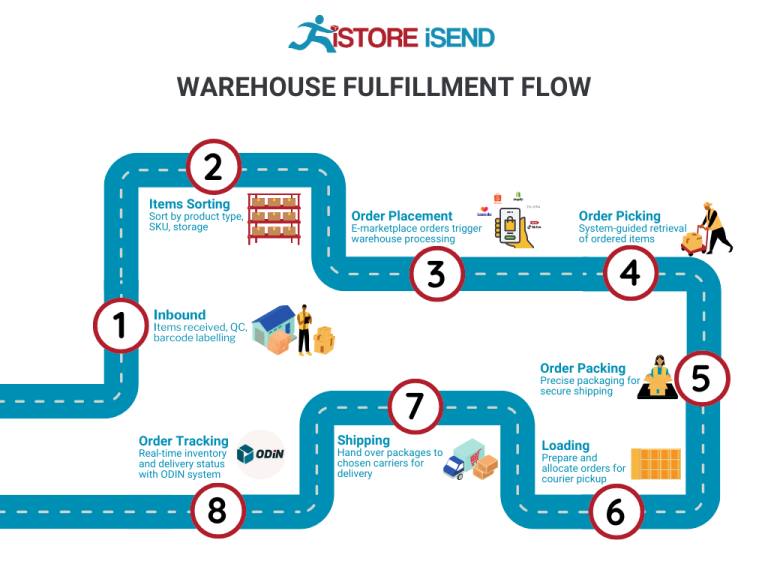
Key Term: Pick Lists
Pick lists streamline the picking process by providing clear instructions for order fulfillment, which minimizes errors and reduces the time spent locating items.
4. Order Packing
Once items are picked, they move to the packing stage. Here, products are securely packaged for shipment, ensuring they arrive at the customer’s door in perfect condition. Effective packing is vital, not only for protecting the products but also for optimizing shipping costs. For instance, using appropriately sized boxes can reduce dimensional weight charges from carriers.
During packing, workers may also include packing slips, which provide customers with order details, or promotional materials to encourage repeat business. Automation technologies, such as packing machines or software solutions that suggest optimal packaging based on the contents, can enhance efficiency and accuracy.
Key Term: Packing Slips
Packing slips are important documents included in shipments that confirm what items are being sent, serving as a receipt for the customer and aiding in returns if necessary.
5. Shipping & Delivery
The final step in the order fulfillment process is shipping and delivery. This involves the coordination of logistics to ensure that packages are dispatched to customers in a timely manner. Efficient shipping is crucial for customer satisfaction, as modern consumers expect fast and reliable delivery.
Businesses must choose the right shipping carriers based on factors such as cost, speed, and service quality. Additionally, providing customers with tracking information enhances transparency and builds trust.
Key Term: Last Mile Delivery
Last mile delivery refers to the final leg of the shipping process, where the package is delivered from a distribution center to the customer’s doorstep. This stage is often the most complex and costly, making it essential for businesses to optimize their last mile strategies to improve efficiency and customer satisfaction.
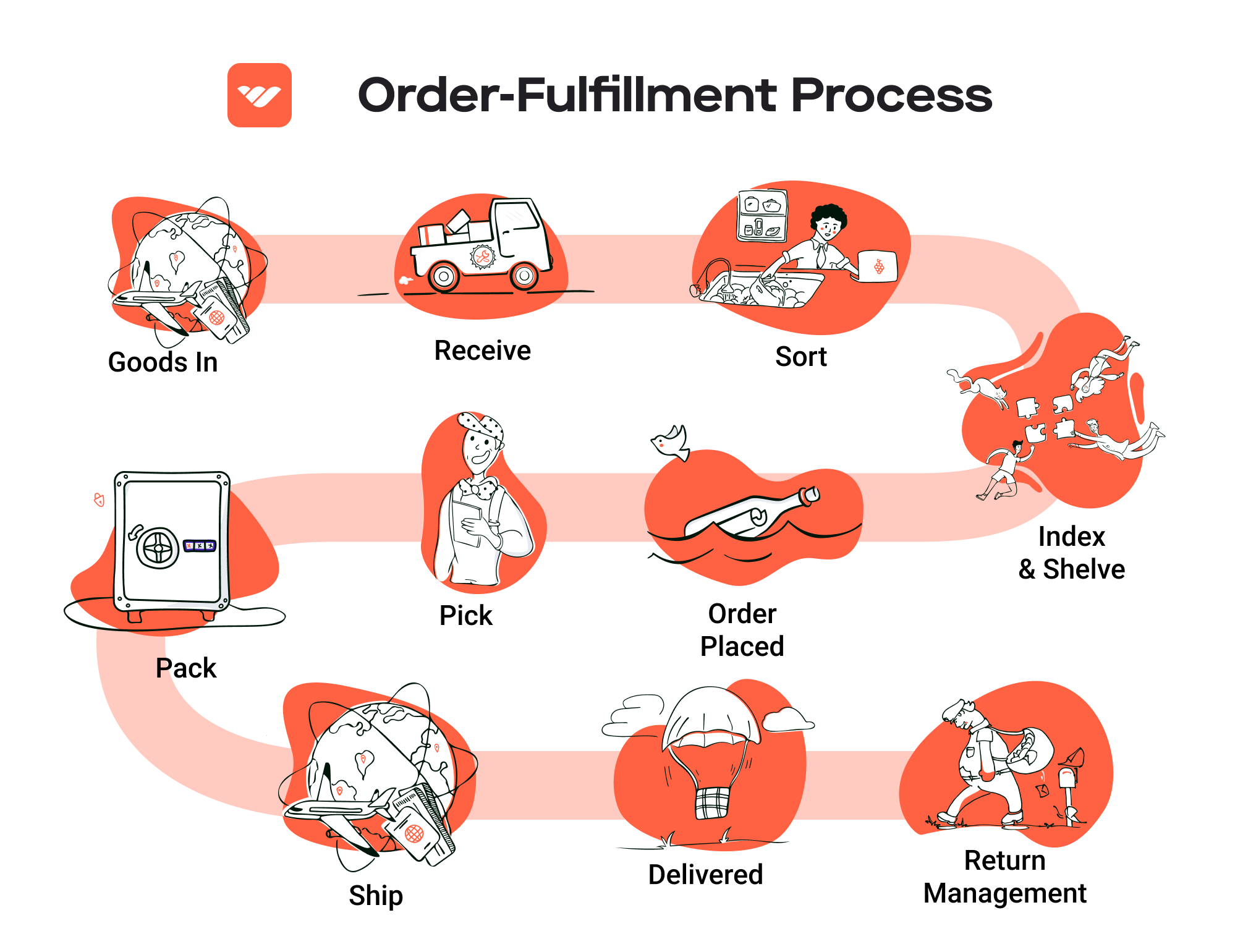
By understanding and efficiently managing each of these steps, e-commerce businesses can scale their operations while maintaining high levels of customer satisfaction, ultimately leading to increased sales and loyalty.
Comparing Fulfillment Models: In-House vs. 3PL vs. Dropshipping
Fulfillment Model Comparison Table
| Model | Who Handles Inventory | Best For (Business Stage) | Key Advantage | Key Disadvantage |
|---|---|---|---|---|
| In-House Fulfillment | The e-commerce business | Startups to mid-sized firms | Full control over inventory and processes | High overhead costs and resource-intensive |
| Third-Party Logistics (3PL) | External logistics provider | Growing businesses | Scalability and expertise | Less control over inventory and fulfillment |
| Dropshipping | Supplier or manufacturer | Startups and niche businesses | Low startup costs and no inventory risk | Lower margins and potential supplier issues |
In-House Fulfillment
In-house fulfillment involves managing inventory and logistics operations within your own facility. This model is often favored by startups and mid-sized firms that require direct control over their inventory, shipping, and customer service processes. Businesses can tailor their fulfillment operations to their specific needs, allowing for customization in packaging and shipping options. Additionally, in-house fulfillment enables businesses to maintain a closer relationship with their products and customers, ensuring quality control and faster response times to customer inquiries. However, the key disadvantage of this model is the high overhead costs associated with maintaining a warehouse, hiring staff, and investing in technology. As a business scales, the complexity of operations can also increase, demanding more resources and management attention.
Third-Party Logistics (3PL)
Third-party logistics (3PL) providers offer outsourced logistics services, including warehousing, fulfillment, and shipping. This model is particularly advantageous for growing businesses that need to scale their operations without the burden of managing logistics internally. By partnering with a 3PL, businesses can leverage the provider’s expertise, technology, and established networks to improve efficiency and reduce costs. 3PLs often have sophisticated systems in place for inventory management and order processing, which can enhance accuracy and speed. However, a major drawback is the reduced control over inventory and fulfillment processes. Businesses may face challenges in communication and alignment with their 3PL partners, and any issues on the provider’s side can directly impact customer satisfaction.
Dropshipping
Dropshipping is a fulfillment model where the retailer does not keep goods in stock. Instead, when a product is sold, the retailer purchases the item from a third party (usually a wholesaler or manufacturer) who then ships it directly to the customer. This model is particularly appealing for startups and niche businesses due to its low barrier to entry and minimal upfront costs. Entrepreneurs can launch their businesses without the financial burden of inventory management and warehousing, allowing them to focus on marketing and customer acquisition. However, dropshipping comes with its own set of challenges. The key disadvantage is the lower profit margins, as retailers often pay higher prices to suppliers than they would if they were buying in bulk. Additionally, retailers have limited control over product quality and shipping times, which can lead to customer dissatisfaction if suppliers do not meet expectations.
Conclusion
When choosing a fulfillment model, e-commerce businesses must consider their specific needs, growth stage, and operational capabilities. In-house fulfillment offers control and customization but requires significant investment and resources. 3PL partnerships provide scalability and expertise but may lead to less control over logistics. Dropshipping minimizes upfront costs and risks but can compromise profit margins and customer experience. Each model has its advantages and disadvantages, and the right choice will depend on the unique circumstances and goals of the business. As companies evolve, they may even find that a hybrid approach—combining elements of these models—best meets their needs.
A Deep Dive into Amazon FBA: Pros, Cons, and Who It’s For
Understanding Fulfillment by Amazon (FBA)
Fulfillment by Amazon (FBA) is a service provided by Amazon that allows sellers to store their products in Amazon’s fulfillment centers. Amazon takes care of storage, packaging, and shipping of the products directly to customers. This system is particularly beneficial for e-commerce businesses looking to streamline their logistics and improve customer satisfaction.
When a customer makes a purchase, Amazon handles the entire fulfillment process, including customer service and returns. Sellers can access Amazon’s vast distribution network, enabling them to deliver products quickly and efficiently. This not only enhances the customer experience but also allows sellers to focus on growing their business without getting bogged down by logistical challenges.
How FBA Works
-
Inventory Management: Sellers send their products to Amazon’s fulfillment centers. Once the products are received, they are stored in Amazon’s warehouses.
-
Order Fulfillment: When a customer places an order, Amazon picks, packs, and ships the product on behalf of the seller. This process is optimized for speed, often resulting in same-day or next-day delivery options for Prime members.
-
Customer Service and Returns: Amazon also manages customer inquiries and returns related to FBA orders. This reduces the burden on sellers and enhances the overall customer experience.
-
Fees: Sellers are charged various fees for using FBA, including storage fees based on the volume of inventory stored and fulfillment fees for each unit shipped.
Pros of Amazon FBA
Prime Eligibility
One of the significant advantages of FBA is the eligibility for Amazon Prime. Products fulfilled by Amazon are marked with the Prime logo, making them more appealing to millions of Prime members who value fast, free shipping. This can significantly increase sales and improve product visibility.
Customer Trust
Customers trust Amazon’s brand and its commitment to service quality. By using FBA, sellers can leverage this trust, as customers are more likely to purchase products that are fulfilled by Amazon due to their reputation for reliability and excellent customer service.
Multi-Channel Fulfillment
FBA is not limited to sales made on Amazon. Sellers can also use FBA to fulfill orders from other sales channels, such as their own e-commerce websites or other marketplaces. This flexibility helps sellers maintain a consistent inventory across multiple platforms while benefiting from Amazon’s fulfillment infrastructure.
Cons of Amazon FBA
High Fees
While FBA provides numerous benefits, the associated fees can be significant. Sellers incur storage fees for keeping their products in Amazon’s warehouses and fulfillment fees for each order shipped. These costs can add up quickly, especially for sellers with low-margin products.
Strict Inventory Rules
Sellers must adhere to Amazon’s strict inventory management rules, including guidelines on packaging, labeling, and shipping. Failure to comply with these regulations can result in additional fees or inventory being returned to the seller, which can disrupt sales and lead to lost revenue.
Commingling Risks
FBA operates on a commingling model where products from different sellers are stored together. This can pose risks for sellers, particularly if there are quality concerns or issues with counterfeit products. If a customer receives a defective item, it can negatively impact the seller’s reputation, even if the fault lies with another seller’s product.
Who is FBA Best For?
Fulfillment by Amazon is ideally suited for:
-
Small to Medium-Sized Businesses: FBA allows smaller businesses to scale their operations without the need for extensive logistics infrastructure. It provides access to Amazon’s vast distribution network, which can be particularly beneficial for those looking to grow quickly.
-
Sellers with High-Volume Products: Businesses that sell products with higher sales volumes can benefit from FBA, as the fulfillment fees can be offset by increased sales and visibility.
-
E-commerce Entrepreneurs: Those who want to focus on marketing and sales rather than logistics will find FBA appealing. It enables sellers to delegate the complexities of fulfillment and customer service to Amazon.
-
Brands Seeking Trust and Visibility: Brands looking to establish credibility and reach a broader audience can leverage FBA to enhance their product listings with Prime eligibility and customer trust associated with Amazon.
In conclusion, Fulfillment by Amazon offers a robust solution for e-commerce businesses aiming to streamline their logistics and enhance customer experience. While there are challenges and costs associated with FBA, the benefits of increased visibility, customer trust, and fulfillment efficiency often outweigh the drawbacks for many sellers. By carefully evaluating their business model and product offerings, entrepreneurs can determine if FBA is the right fit for their growth strategy.
Core Services Offered by Fulfillment Centers
Inventory Management & Warehousing
Inventory management and warehousing form the backbone of any successful fulfillment operation. Fulfillment centers provide businesses with the infrastructure to store their products efficiently. This service includes tracking inventory levels, managing stock replenishment, and maintaining optimal stock levels to meet demand without overstocking.
Benefits:
1. Real-Time Visibility: Modern fulfillment centers utilize sophisticated inventory management systems that offer real-time tracking of stock levels. This enables e-commerce businesses to make informed decisions about restocking and managing their inventory effectively.
-
Space Optimization: By leveraging the warehouse space provided by fulfillment centers, businesses can avoid the costs and complexities of managing their own storage facilities. Fulfillment centers are designed for efficiency, often featuring advanced shelving systems that maximize storage space.
-
Scalability: As an e-commerce business grows, so does its inventory. Fulfillment centers allow businesses to scale their warehousing needs without the hassle of relocating or expanding their own facilities. This flexibility is crucial for accommodating seasonal fluctuations or unexpected spikes in demand.
Pick and Pack Services
Pick and pack services are essential for preparing orders for shipment. This process involves selecting the ordered items from the warehouse (picking) and then packaging them for delivery (packing). Fulfillment centers employ trained staff and automated systems to ensure accuracy and efficiency in this critical stage of order fulfillment.
Benefits:
1. Speed and Efficiency: With streamlined processes and technology, fulfillment centers can significantly reduce the time it takes to prepare an order. Faster order processing leads to quicker delivery times, enhancing customer satisfaction and loyalty.
-
Accuracy: Mistakes in order fulfillment can lead to costly returns and dissatisfied customers. Fulfillment centers implement quality control measures to minimize errors during the picking and packing process, ensuring that customers receive the correct items.
-
Custom Packaging Options: Fulfillment centers often provide customized packaging solutions that can enhance branding and improve customer experience. This includes branded boxes, inserts, and other packaging materials that reflect the company’s image and values.
Kitting and Assembly
Kitting and assembly refer to the process of combining multiple products into a single package or preparing items for sale as a set. This service is particularly beneficial for businesses offering subscription boxes, gift sets, or product bundles. Fulfillment centers can handle the labor-intensive aspects of kitting and assembly, allowing businesses to focus on their core operations.
Benefits:
1. Enhanced Product Offerings: By utilizing kitting services, e-commerce businesses can create unique product offerings that appeal to customers, such as themed bundles or promotional kits. This not only drives sales but also differentiates the brand in a competitive market.
-
Reduced Time and Labor Costs: Kitting can be labor-intensive, requiring specific skills and time to assemble products correctly. By outsourcing this process to a fulfillment center, businesses can save on labor costs and reduce the burden on their staff.
-
Improved Inventory Management: Kitting allows businesses to manage inventory more effectively by grouping items together. This can lead to more efficient stock management and a clearer understanding of sales trends for bundled products.
Returns Management (Reverse Logistics)
Returns management, often referred to as reverse logistics, is a critical service provided by fulfillment centers. It involves handling the return of products from customers back to the warehouse. Efficient returns management is essential for maintaining customer satisfaction and minimizing losses.
Benefits:
1. Streamlined Processes: Fulfillment centers establish clear procedures for processing returns, which can include inspecting returned items, restocking, and managing refunds. A streamlined returns process helps businesses handle customer dissatisfaction swiftly, improving overall customer experience.
-
Data Insights: By analyzing return data, fulfillment centers can provide valuable insights into product performance and customer preferences. This information can inform inventory decisions, product improvements, and marketing strategies.
-
Cost Reduction: Effective returns management can help businesses reduce the costs associated with returned merchandise. By minimizing the time and resources spent on handling returns, e-commerce companies can improve their bottom line.
By leveraging these core services offered by fulfillment centers, e-commerce businesses can enhance their operational efficiency, improve customer satisfaction, and scale effectively in an increasingly competitive marketplace. Understanding and utilizing these services is key to building a successful e-commerce operation that can adapt to changing market dynamics and customer needs.
How to Choose a Fulfillment Partner: A 6-Point Checklist
Location & Warehouse Network
Importance: The geographical placement of your fulfillment partner’s warehouses can significantly affect shipping times and costs. Proximity to your customer base can lead to faster delivery, which is critical for maintaining customer satisfaction and loyalty.
Questions to Ask:
– How many fulfillment centers do you operate, and where are they located?
– Can you provide a map of your warehouse network and any planned expansions?
– What are your average shipping times to major metropolitan areas?
– How do you manage inventory across multiple locations?
Technology & Integrations
Importance: A robust technological framework is essential for efficient order processing, inventory management, and real-time tracking. Integration with your existing e-commerce platform is also crucial for seamless operations.
Questions to Ask:
– What technology do you use for inventory management and order fulfillment?
– Can your system integrate with my e-commerce platform (e.g., Shopify, WooCommerce, Amazon)?
– Do you offer real-time tracking capabilities for both my business and customers?
– How do you handle data security and compliance with regulations like GDPR?
Specializations (e.g., cold storage, oversized items)
Importance: Depending on your product range, you may require specific handling capabilities. For example, if you sell perishable goods, you need a partner that offers cold storage. If you deal with bulky items, the partner should have the necessary infrastructure.
Questions to Ask:
– Do you have experience handling my specific product types?
– What specializations do you offer (e.g., cold storage, hazardous materials, oversized items)?
– How do you ensure the quality and integrity of specialized products during storage and shipping?
– Can you accommodate custom packaging or specific handling requirements?
Scalability & Capacity
Importance: As your business grows, your fulfillment partner must be able to scale operations accordingly. This includes having the capacity to handle increased order volumes and the flexibility to adapt to seasonal spikes.
Questions to Ask:
– What is your current capacity, and how do you plan to scale in the future?
– Can you handle peak seasons or unexpected surges in order volume?
– What steps do you take to ensure efficient operations during high-demand periods?
– How do you manage inventory fluctuations and storage space?
Pricing and Contracts
Importance: Understanding the pricing structure is essential for budgeting and financial planning. Look for transparency in costs to avoid hidden fees that can impact your margins.
Questions to Ask:
– Can you provide a detailed breakdown of your pricing model?
– Are there additional fees for services like returns processing, storage, or packaging?
– What is the minimum contract length, and are there penalties for early termination?
– How do you handle price increases, and how often do they occur?
Customer Support & Reviews
Importance: Quality customer support can make a significant difference in your experience with a fulfillment partner. Responsive support can help resolve issues quickly, minimizing disruptions to your business.
Questions to Ask:
– What customer support channels do you offer (e.g., phone, email, chat)?
– What are your typical response times for support inquiries?
– Can you provide references or case studies from existing clients?
– How do you handle disputes or service failures?
Choosing the right fulfillment partner is crucial for the success of your e-commerce business. By using this checklist, you can ensure that you select a partner that aligns with your operational needs and growth goals. Each point addresses critical aspects of the fulfillment process, helping you make an informed decision that supports your business objectives.
Understanding Fulfillment Pricing: A Breakdown of Common Fees
Initial Setup Fees
Initial setup fees are one-time charges incurred when you first establish your account with a fulfillment center. These fees can vary significantly based on the complexity of your operations and the specific services offered by the fulfillment center. Typically, they cover the costs associated with account creation, onboarding, and the integration of your e-commerce platform with the fulfillment software.
Calculation: Initial setup fees are often calculated as a flat rate, which may range from a few hundred to several thousand dollars, depending on the level of service and customization required. Factors influencing this fee include the number of products you plan to fulfill, the integration needed, and any special requirements like custom packaging.
Receiving Fees
Receiving fees are charged for the process of accepting and processing inventory once it arrives at the fulfillment center. This includes inspecting, labeling, and storing your products in the warehouse.
Calculation: These fees are usually based on the number of units received or a per-pallet basis. For example, a fulfillment center may charge a fee per 100 units received or a flat fee for each pallet. It’s essential to clarify whether these fees cover only the basic receiving process or if they include additional services like quality checks or labeling.
Storage Fees (per pallet/bin)
Storage fees are recurring charges for holding your inventory in the fulfillment center’s warehouse. These fees are typically calculated on a monthly basis and can be charged per pallet, bin, or cubic foot, depending on the fulfillment center’s pricing structure.
Calculation: The calculation method can vary widely. For instance, you may see fees like $15 per pallet per month or $0.75 per cubic foot. It’s important to understand how the fulfillment center defines a pallet or bin, as different centers may have different dimensions or weight limits that affect your overall storage costs. Be sure to factor in seasonal fluctuations in inventory levels, as this can significantly impact your storage fees.
Pick & Pack Fees (per item/order)
Pick and pack fees are charged for the service of selecting items from your inventory and packing them for shipment. This fee is critical as it directly affects your order fulfillment costs and can vary based on the complexity of the order.
Calculation: Typically, pick and pack fees are structured on a per-item basis or per-order basis. For example, a fulfillment center might charge $1.00 per item picked and packed or a flat fee of $3.00 per order, regardless of the number of items. Be aware that additional charges may apply for special packing requirements, like gift wrapping or custom packaging.
Shipping Fees
Shipping fees are the costs associated with transporting your products from the fulfillment center to your customers. These fees can vary based on several factors, including the shipping method chosen, the destination, and the size and weight of the packages.
Calculation: Shipping fees are generally calculated based on the carrier’s rates, which can differ widely. Fulfillment centers often have partnerships with shipping providers and may offer discounted rates. You might encounter flat rates for specific regions or variable rates based on weight and dimensions. It’s essential to understand whether the shipping fees include tracking, insurance, and delivery confirmation, as these can add to the overall cost.
Tips for Getting an Accurate Quote
-
Provide Detailed Information: When requesting a quote, provide detailed information about your product dimensions, weights, and expected order volumes. The more precise your data, the more accurate the quote.
-
Ask About Hidden Fees: Inquire about any potential hidden fees that may not be included in the initial quote, such as charges for special handling, returns, or additional services.
-
Compare Multiple Fulfillment Centers: Don’t settle for the first quote you receive. Compare pricing and services from multiple fulfillment centers to ensure you’re getting the best value for your specific needs.
-
Understand Seasonal Variability: Discuss how your storage and fulfillment costs may fluctuate during peak seasons. Some fulfillment centers offer better rates during off-peak times, so it’s worth exploring these options.
-
Negotiate: Don’t hesitate to negotiate terms and pricing. Many fulfillment centers are willing to adjust their fees based on your projected volume or long-term commitment.
By understanding these common fees and how they are calculated, you can better prepare your e-commerce business for the costs associated with fulfillment services and make informed decisions that align with your growth strategy.
Frequently Asked Questions (FAQs) about Fulfillment
1. What is Amazon Fulfillment Center DMH4?
Amazon Fulfillment Center DMH4 is a state-of-the-art logistics facility operated by Amazon, primarily designed for efficiently processing and shipping orders for e-commerce businesses. Located in a strategic area, DMH4 utilizes advanced technology and automation to handle a high volume of inventory, ensuring quick and accurate order fulfillment.
2. What services does Amazon Fulfillment Center DMH4 provide?
DMH4 offers a range of services, including receiving and storing inventory, picking and packing orders, shipping products directly to customers, and managing returns. These services are tailored to support both large and small e-commerce businesses, allowing them to focus on growth while Amazon handles the logistics.
3. How does DMH4 differ from a traditional warehouse?
A traditional warehouse typically focuses on storage and inventory management, while a fulfillment center like DMH4 emphasizes the entire order fulfillment process, including picking, packing, and shipping. Fulfillment centers are equipped with advanced technology and systems designed to optimize the speed and accuracy of order processing.
4. What is a third-party logistics provider (3PL)?
A third-party logistics provider (3PL) is a company that offers outsourced logistics services, including warehousing, transportation, and order fulfillment. By partnering with a 3PL like Amazon Fulfillment Center DMH4, e-commerce businesses can streamline their operations, reduce overhead costs, and enhance customer satisfaction through faster shipping.
5. How much do fulfillment services cost?
The cost of fulfillment services can vary widely based on factors such as the volume of orders, the types of products being shipped, and the specific services required. Typically, fees may include storage costs, picking and packing fees, and shipping charges. It’s essential for businesses to analyze their needs and obtain detailed pricing from fulfillment centers like DMH4.
6. How does the order fulfillment process work at DMH4?
At DMH4, the order fulfillment process begins when a customer places an order online. The system automatically triggers a pick list, directing warehouse staff to retrieve the items from inventory. Once picked, the items are packed and labeled for shipping, and the order is dispatched to the customer via the most efficient shipping method available.
7. Can small businesses use Amazon Fulfillment Center DMH4?
Yes, small businesses can leverage the services of Amazon Fulfillment Center DMH4. The facility is designed to accommodate businesses of all sizes, providing scalable solutions that grow with the business. Small businesses benefit from Amazon’s extensive logistics network and expertise, allowing them to compete more effectively in the marketplace.
8. What technology does DMH4 use to enhance fulfillment efficiency?
DMH4 employs a variety of advanced technologies, including automated sorting systems, robotics for picking and packing, and sophisticated inventory management software. These technologies work together to streamline operations, reduce human error, and speed up the order fulfillment process.
9. How can businesses track their inventory at DMH4?
Businesses utilizing DMH4 can track their inventory through Amazon’s seller portal, which provides real-time updates on stock levels, order statuses, and shipment tracking. This transparency allows businesses to manage their inventory effectively and make informed decisions regarding reordering and stock management.
10. What should businesses consider when choosing a fulfillment center like DMH4?
When selecting a fulfillment center, businesses should consider several factors, including the center’s location, the range of services offered, technology capabilities, pricing structure, and customer service. It’s crucial to evaluate how well the fulfillment center can meet your specific needs and support your growth objectives.
Conclusion: Is Outsourcing Fulfillment the Right Move for Your Business?
Assessing the Benefits of Outsourcing Fulfillment
Outsourcing fulfillment can be a transformative decision for e-commerce businesses looking to scale operations effectively. By leveraging a dedicated fulfillment partner, companies can save valuable time and resources that would otherwise be spent on managing logistics and inventory. This time savings allows business owners and operations managers to focus on core activities such as product development, marketing strategies, and customer engagement—key areas that drive growth.
Scalability is another significant advantage. As demand fluctuates, fulfillment services provide the flexibility to scale operations up or down without the burden of managing additional warehouse space or staffing. This adaptability is crucial for businesses that experience seasonal spikes or rapid growth. Furthermore, fulfillment centers often come equipped with advanced technology and expertise in logistics, ensuring that orders are processed efficiently and accurately. This not only enhances customer satisfaction but also reduces the risk of costly errors.
However, the success of outsourcing fulfillment hinges on selecting the right partner. It’s essential to conduct thorough due diligence when evaluating potential fulfillment providers. Look for partners that align with your business goals and can accommodate your specific needs, whether that’s fast shipping, specialized packaging, or international reach.
As you consider your next steps, take the time to audit your current shipping processes. Analyze your fulfillment costs, delivery times, and customer feedback. By understanding your operations, you can determine if a fulfillment partner is the right move for your business. Embrace the opportunity to streamline logistics and focus on scaling your sales—your growth journey may depend on it.
Important Disclaimer
⚠️ Important Disclaimer
The information in this guide is for educational purposes. Fulfillment services, pricing, and platform features change frequently. Always conduct your own due diligence and consult with providers directly before making business decisions.
